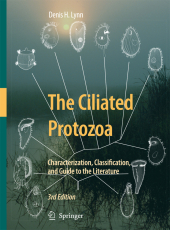 Neuerscheinungen 2011Stand: 2020-01-07 |
Schnellsuche
ISBN/Stichwort/Autor
|
Herderstraße 10
10625 Berlin
Tel.: 030 315 714 16
Fax 030 315 714 14
info@buchspektrum.de |

Denis H. Lynn
The Ciliated Protozoa
Characterization, Classification, and Guide to the Literature
3rd ed. 2011. XXXIII, 605 p. w. figs. 266 x 203 mm
Verlag/Jahr: SPRINGER NETHERLANDS 2011
ISBN: 1-402-08238-X (140208238X)
Neue ISBN: 978-1-402-08238-2 (9781402082382)
Preis und Lieferzeit: Bitte klicken
distances between groups of ciliates were as vast as significant hurdles to obtain copyright permissions the genetic distances between plants and animals for the over 1,000 required illustrations, and I put - THE major eukaryotic kingdoms at that time! the publication schedule ahead of this element. I continued to collaborate with Mitch, and in There are a number of significant illustrated guides 1991 my first "molecular" Magisterial student, to genera and species that have recently been pub- Spencer Greenwood, published an article estab- lished. References are made to these throughout lishing 1990 or thereabouts as the beginning of the book as sources that readers can consult for this the "Age of Refinement" - the period when gene aspect of ciliate diversity. A future project that I am sequencing techniques would deepen our under- contemplating is an illustrated guide to all the valid standing of the major lines of evolution within ciliate genera.
Dedication.- Acknowledgements.- Preface to Third Edition.- List of Tables.- List of Figures.- Introduction and Progress in the Last Half Century.- Glossary of Terms and Concepts Useful in Ciliate Systematics.- Characters and the Rationale behind the New Classification.- Phylum CILIOPHORA - Conjugating, Ciliated Protists with Nuclear Dualism.- Subphylum 1. POSTCILIODESMATOPHORA: Class 1. Karyorelictea - The ´Dawn´ or Eociliates.- Subphylum 1. POSTCILIODESMATOPHORA: Class 2. Heterotrichea - Once Close to the Top.- Subphylum 2. INTRAMACRONUCLEATA: Class 1. Spirotrichea - Ubiquitous and Morphologically Complex.- Subphylum 2. INTRAMACRONUCLEATA: Class 2. Armophorea - Sapropelibionts That Once Were Heterotrichs.- Subphylum 2. INTRAMACRONUCLEATA: Class 3. Litostomatea - Simple Ciliates but Highly Derived.- Subphylum 2. INTRAMACRONUCLEATA: Class 4. Phyllopharyngea - Diverse in Form, Related in Structure.- Subphylum 2. INTRAMACRONUCLEATA: Class 5. Nassophorea - Diverse, Yet Still Possibly Pivotal.- Subphylum 2. INTRAMACRONUCLEATA: Class 6. Colpodea - Somatically Conserved but Orally Diverse.- Subphylum 2. INTRAMACRONUCLEATA: Class 7. Prostomatea - Once Considered Ancestral, Now Definitely Derived.- Subphylum 2. INTRAMACRONUCLEATA: Class 8. Plagiopylea - A True Riboclass of Uncommon Companions.- Subphylum 2. INTRAMACRONUCLEATA: Class 9. Oligohymenophorea - Once a Pivotal Group, Now a Terminal Radiation.- Deep Phylogeny, Gene Sequences, And Character State Evolution - Mapping The Course Of Ciliate Evolution.- The Ciliate Taxa Including Families And Genera.- References.- Subject Index.- Systematic Index.
From the reviews of the third edition:
"The book is a combination of rigour, detail, and clarity. The prose is succinct and accessible, and the illustrations ... are appropriate ... . Of course, protozoologists will benefit from owning, or having access to this book, but others including applied and pure ecologist and broad range of phylogenists, microbiologists, and ultrastruturalists will appreciate its content and views. ... it is a comprehensive reference work for students, teachers, and researchers interested in ciliate phylogeny, taxonomy, life histories, structure, and function." (David J.S. Montagnes, Limnology and Oceanography Bulletin, Vol. 18 (1), March, 2009)
Dr. Denis H. Lynn received his graduate training at the University of Toronto where he received his Ph.D. Protozoology in 1975. His early research on the comparative ultrastructure of ciliates was published in Biological Reviews and lead to a revised classification of the Phylum Ciliophora, which was published in 1981 in collaboration with Eugene B. Small. Dr. Lynn has published extensively on ciliates, authoring more than a dozen book chapters and almost 120 refereed publications. He is currently a full professor in the Department of Integrative Biology, University of Guelph, and Editor in Chief of The Journal of Eukaryotic Microbiology.


